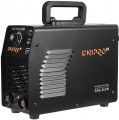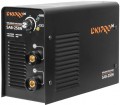Open circuit voltage
The voltage supplied by the welding machine to the electrodes. As the name suggests, it is measured without load — i.e. when the electrodes are disconnected and no current flows between them. This is due to the fact that at a high current strength characteristic of electric welding, the actual voltage on the electrodes drops sharply, and this does not make it possible to adequately assess the characteristics of the welding machine.
Depending on the characteristics of the machine (see "Type") and the type of work (see "Type of welding"), different open circuit voltages are used. For example, for welding transformers, this parameter is about 45 – 55 V (although there are higher voltage models), for inverters it can reach 90 V, and for semi-automatic MIG / MAG welding, voltages above 40 V are usually not required. Also, the optimal values \u200b\u200bdepend on type of electrodes used. You can find more detailed information in special sources; here we note that the higher the open-circuit voltage, the easier it is usually to strike the arc and the more stable the discharge itself.
Also note that for devices with the VRD function (see "Advanced"), this parameter indicates the standard voltage, without reduction through VRD.
Max. welding current
The highest current that the welding machine is capable of delivering through the electrodes during operation. In general, the higher this indicator, the thicker the electrodes the device can use and the greater the thickness of the parts with which it can work. Of course, it does not always make sense to chase high currents — they are more likely to damage thin parts. However, if you have to deal with large-scale work and a large thickness of the materials to be welded, you simply cannot do without a device with the appropriate characteristics. Optimum welding currents depending on materials, type of work (see "Type of welding"), type of electrodes, etc. can be specified in special tables. As for specific values, in the most “weak” models, the maximum current
does not even reach 100 A, in the most powerful ones it can exceed
225 A and even
250 A.Insulation class
The insulation class determines the degree of resistance of the insulating materials used in a particular device to heat. To date, welding machines use materials mainly of the following classes:
B — have a resistance limit of 130 °C;
F — 155 °C;
H — 180 °C.
Note that the vast majority of modern welding machines have electronic overheating protection, which turns off the device long before reaching the insulation resistance limit. Therefore, this parameter will be relevant only in an emergency, when the built-in protection fails. Nevertheless, it fully allows you to assess the safety of using the device — the higher the insulation class, the more likely it is to notice dangerous overheating in time (for example, by a characteristic smell) and turn off the device before damage occurs.

